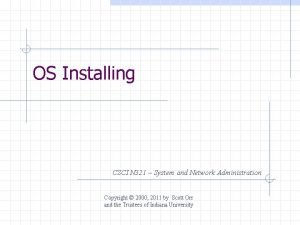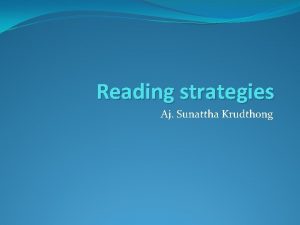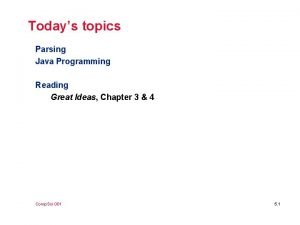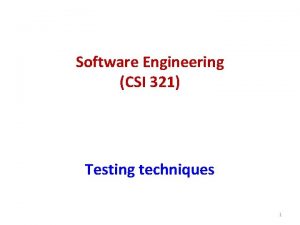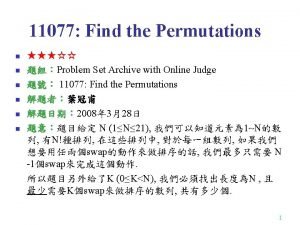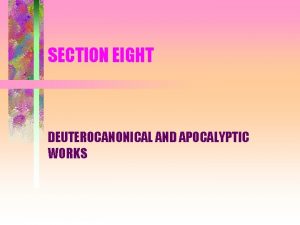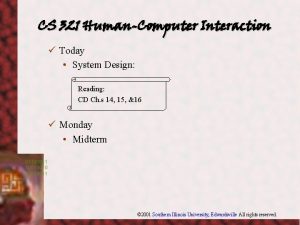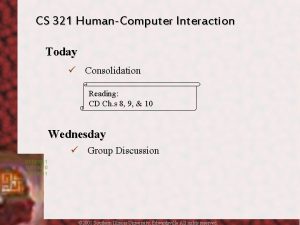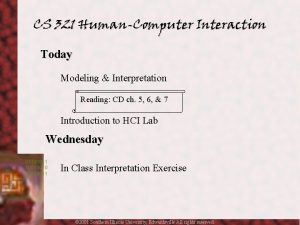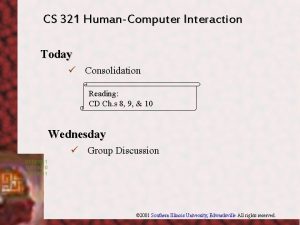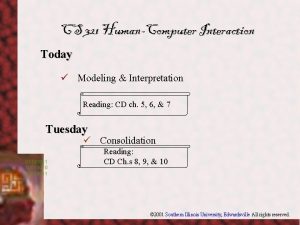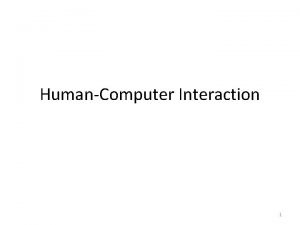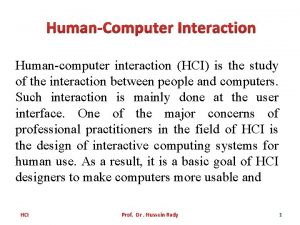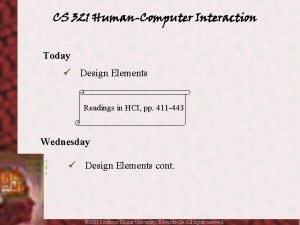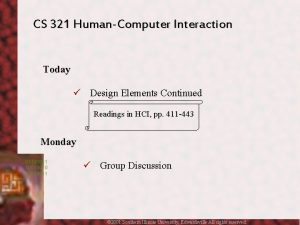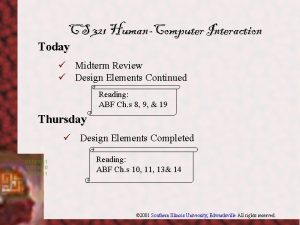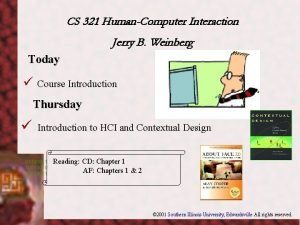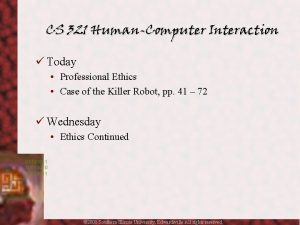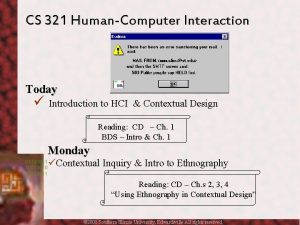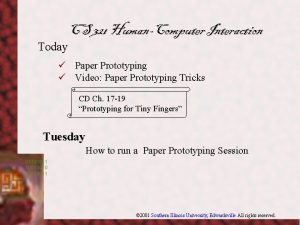CS 321 HumanComputer Interaction Today System Design Reading















- Slides: 15

CS 321 Human-Computer Interaction ü Today • System Design: Reading: CD Ch. s 14, 15, &16 ü Monday • Midterm © 2001 Southern Illinois University, Edwardsville All rights reserved.

Coherent Design ü The design should strive for a coherent system • “A coherent system keeps the user’s work orderly and natural. ” • Coherent system means everything seems to fit together and tasks flow in an logical order. ü Not a patchwork of functionality • Particularly important for large, complex projects and for team development © 2001 Southern Illinois University, Edwardsville All rights reserved.

Road Map ü You interviewed the users and observed them doing their work: Contextual Inquiry (Ch. 2 -4) ü You modeled each individual to recognize concerns, strategies, and practices: Work Models (ch. 5 -7) ü You consolidated the models to recognize commonality and differences: Consolidated Work Models & Affinity Diagram (ch. 8 -10) ü You recognized the implications of the data for design and (possibly) re-design: Innovation from data (ch. 1113) © 2001 Southern Illinois University, Edwardsville All rights reserved.

Visioning ü Now its time for Design ü Your team is to “vision” a system that supports and (possibly) re-designs the work: Visioning & Storyboards (ch. 14 -16) © 2001 Southern Illinois University, Edwardsville All rights reserved.

Steps to Creative Design 1. Walk the Data Immerse yourself in the data by “walking the wall” § § § Discuss what matters to the user List available technologies List design starting points © 2001 Southern Illinois University, Edwardsville All rights reserved.

Steps to Creative Design 2. Envision the System Hold a team “Visioning Session” § § § Take a starting point Create a story of how the user will use the system “The pen” draws a picture of the ideas Practicality is not a major consideration at this point Should be fun! © 2001 Southern Illinois University, Edwardsville All rights reserved.

Vision © 2001 Southern Illinois University, Edwardsville All rights reserved.

Steps to Creative Design 3. Evaluate and Integrate • For each vision list positive and negative points • Look across the visions to identify core positive points your team doesn’t want to lose • Draw a consolidated vision 4. Storyboard • Fill in details of the application © 2001 Southern Illinois University, Edwardsville All rights reserved.

Keeping Coherence ü Division-of-Labor Approach • Divide system up among team members • Tends to create a “patchwork” application ü Contextual Design Approach • User Environment Design (UED) • Creates a structure of the work © 2001 Southern Illinois University, Edwardsville All rights reserved.

UED ü “Blue print” of virtual work environment • “Places”: rooms where work happens • “Functions”: activities that are performed in the room • “Links”: Corridors to move between rooms © 2001 Southern Illinois University, Edwardsville All rights reserved.

Beyer & Holtzblat (1998), Contextual Design, Morgan Kaufmann, Page: 307 © 2001 Southern Illinois University, Edwardsville All rights reserved.

UED ü Focus Areas: supports a specific aspect of the work ü Purpose: state of work the focus area supports ü Functions, objects, constraints: elements of focus area ü Link: movement between focus areas ü Hidden Areas: focus areas that support work but do no directly interact with user ü Double Link: work of one focus area done in the context of another © 2001 Southern Illinois University, Edwardsville All rights reserved.

Beyer & Holtzblat (1998), Contextual Design, Morgan Kaufmann, Pages: 328, 329 © 2001 Southern Illinois University, Edwardsville All rights reserved.

UED to UID ü The UED is the specification for the User Interface Design (UID) ü The UED indicates what functions should be available and where to put them BUT it leaves open how the interface should work ü UED precedes UID • UID is too detailed to see the overall work structure © 2001 Southern Illinois University, Edwardsville All rights reserved.

Summary 1. Understand the structure of the work as it exists (Contextual Inquiry & work models) 2. Become knowledgeable about the possibilities of re-design (Consolidation) 3. Envision a brave, brave new world (Visioning) 4. Work out the implications (Storyboard) 5. Create the system structure (UED) © 2001 Southern Illinois University, Edwardsville All rights reserved.
 While reading activities
While reading activities 321 system
321 system For today's meeting
For today's meeting Todays class
Todays class Today meeting or today's meeting
Today meeting or today's meeting Fingerprint galton details
Fingerprint galton details Today's lesson or today lesson
Today's lesson or today lesson Today's lesson or today lesson
Today's lesson or today lesson As we understand from the reading today soil erosion
As we understand from the reading today soil erosion Reading for today topics 5
Reading for today topics 5 Reading for today issues 3 해석
Reading for today issues 3 해석 Edel 321
Edel 321 321 vs 338 fiduciary
321 vs 338 fiduciary Csi 321
Csi 321 132 213
132 213 Apokalypsis 321
Apokalypsis 321

